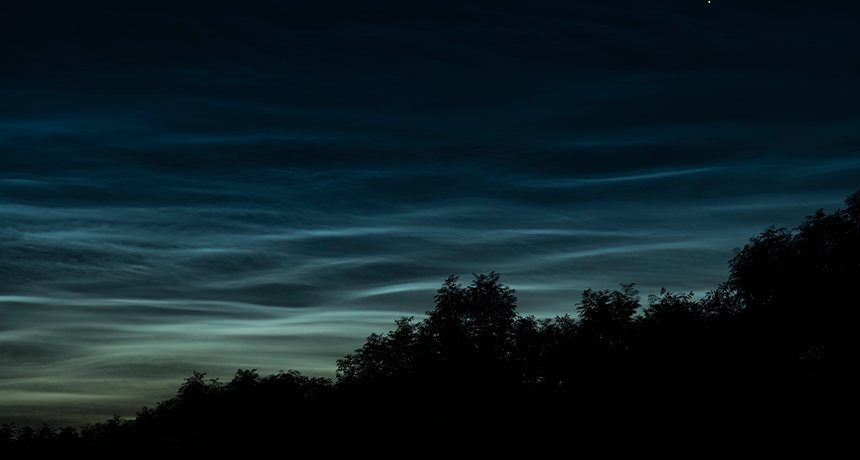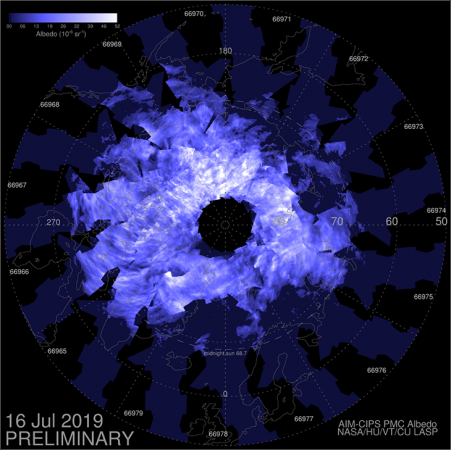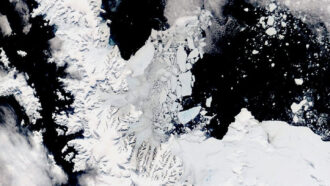Explainer: Why some clouds glow in the dark
In a warming world, noctilucent clouds might become more common far from polar skies

Noctilucent clouds glow in blue hues after twilight. They are rare in non-polar skies. But with climate change, that might change, scientists report.
Sjo/iStock/Getty Images Plus
A glowing cloud lit up Northern California’s skies on December 19, 2018. Thousands of people in San Francisco, Calif., gawked at the eerie neon-blue spiral that loomed for an hour after sunset. Even the National Weather Service was baffled by what could have caused it.
Then dashcam video emerged. It showed the instigator was from out of this world. A meteor left a trail of dust that created the noctilucent (Nok-tih-LU-sint) cloud. The cloud’s name comes from Latin words for “night-lit.”
airirin/YouTube
Smoke from the burning space rock “seeded” Earth’s upper atmosphere with dust. Water vapor can condense around those dust bits to form clouds. Meteors burn up high in the atmosphere. So these noctilucent clouds also form high up.
Given the curvature of the Earth, objects high in the sky can still catch some sunlight well after the sun sets closer to the ground. Noctilucent clouds’ extreme height is what keeps them shining in the dark. And they appear blue because all of the other wavelengths of light have scattered.
Noctilucent clouds typically emerge at high latitudes, meaning near or over the poles. They almost never appear above the lower 48 U.S. states — not unless the atmosphere there gets some help, as it did that December night.
Reports of the glowing cloud had begun pouring in around 5:40 p.m. Onlookers flooded the local National Weather Service office with pictures. Many also began guessing at the cloud’s cause. A rocket launch, for instance, might explain it.
United Launch Alliance did have a launch scheduled for that night. This company specializes in building and launching spacecraft. That night, a rocket armed with a top-secret spy satellite was due to take off from Vanderberg Air Force Base, south of San Francisco. But 9 minutes before blastoff, the launch was scrubbed. So its rocket did not produce the eerie cloud.
The next day, the American Meteor Society (AMS) described 180 eyewitness accounts of what did: a meteor. A so-called fireball, it appeared brighter than Venus as it burned up in Earth’s atmosphere. AMS estimated that the space rock broke apart over open water some 56 kilometers (35 miles) west of the Golden Gate Bridge.
Although space rocks commonly enter Earth’s atmosphere, they have seldom spawned clouds. The reason: Those rocks tend to break apart too high. The mesosphere, where the breakups typically happen, is some 81 kilometers (50 miles) above the ground. It hosts very little water.
But that could change. More water is entering the upper atmosphere as Earth’s climate warms.
A pivotal role for space rocks
For a noctilucent cloud to form, the mesosphere must be super cold — below –40° Celsius (–40° Fahrenheit). These temps develop above Earth’s poles in the summer. Near the Arctic, that means peak noctilucent season is June through August. Peak season near Antarctica is December through February.
At those low temperatures, the air is dry. And at such high altitudes, the air is also relatively dust-free. Without some dust particle to glom onto, any moisture here tends not to freeze; it is “supercooled.”

But that can change with the arrival of meteor smoke. With something to freeze onto, the supercooled droplets rapidly turn to ice. Once one ice crystal forms, more join it in what becomes a chain reaction. If the process is large enough, a noctilucent cloud develops.
About 3 percent of each ice crystal in a noctilucent cloud comes from meteors, says atmospheric scientist Mark Hervig. He works at the aerospace company GATS, Inc., in Newport News, Va. Hervig led a team that found the strong link between meteor smoke and noctilucent clouds.
The researchers analyzed data collected by NASA’s AIM mission. AIM stands for Aeronomy of Ice in the Mesosphere. The team’s findings suggest meteor smoke is the main trigger for the formation of these luminous clouds. Tiny smoke particles serve as the core around which ice crystals form.
The inner solar system is littered with meteors of all shapes and sizes, but mostly small stuff. Earth’s atmosphere collects tons of these itty bitty meteors. Once inside Earth’s atmosphere, they’ll burn up. This leaves behind a haze of tiny particles suspended at an altitude of 70 to 100 kilometers (43 to 62 miles).
“It’s no coincidence that noctilucent clouds form 83 kilometers high, squarely inside the meteor smoke zone,” Hervig says.
The coming climate for noctilucent clouds
Today, noctilucent clouds seldom develop outside the Arctic and Antarctic. But that might not be true for long. Indeed, these clouds have already begun to creep down into the regions between the poles and the tropics. One reason seems to be the increasing presence of methane at high altitudes.
High up in the mesosphere, methane takes part in a complex chemical reaction that forms new molecules of water. “Water vapor can increase if methane increases,” says atmospheric scientist James Russell. Every methane molecule can produce two water molecules in the mesosphere, Russell explains. He works with NASA’s AIM mission at Hampton University in Virginia. There, he is part of a group that studies noctilucent clouds.
The atmospheric sciences community has likened noctilucent clouds outside of polar skies as a potential symptom of climate change.
Methane, a potent greenhouse gas, can be released into the sky by thawing permafrost, burping cows, biomass burning and more. Increasing methane levels may boost the amount of water in the mesosphere. In turn, that could improve chances for noctilucent clouds.
Rising levels of another greenhouse gas, carbon dioxide, may also play a role. As CO2 boosts air temperatures near the ground, it can cause temps in the mesosphere to drop, Russell explains. That cooling effect could help supercool more water — a key ingredient for noctilucent clouds.
In step with rising greenhouse gases, the breadth and frequency of glowing clouds have increased over the last few decades, climate research hints.
Gary Thomas is an atmospheric scientist at the University of Colorado, Boulder. From 1964 to 1986, noctilucent clouds covered more and more of the sky high above the poles, his team found. These clouds also ventured toward Earth’s equator, beyond their normal territory. And increased methane played a key role in the clouds’ spread. The team reported its findings in 2001 in Advances in Space Research.
Glowing clouds are not only spreading farther across the sky. Since 1998, they have also been appearing more often and getting brighter. A team of German researchers reported those findings in a 2015 study.
Russell says the expansion of noctilucent clouds could be an indicator of climate change. More study is needed to confirm this, he says. But it certainly makes scientists wonder, he says: “Is climate change occurring on the edge of space?”







